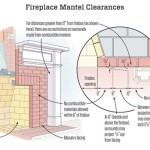Determining the Optimal Height for a Television Above a Fireplace
Mounting a television above a fireplace is a popular design choice in many homes, offering a visually appealing and space-saving solution. However, achieving the right viewing experience necessitates careful consideration of the television's height. An improperly positioned television can lead to neck strain, discomfort, and a diminished overall viewing experience. Understanding the factors that contribute to optimal television placement is crucial to ensuring comfort and preventing potential health issues.
The primary consideration when determining the ideal height is minimizing neck strain. Regularly tilting the head upwards to view a television positioned too high can lead to discomfort and even chronic pain over time. This is particularly important for individuals who spend extended periods watching television. Therefore, prioritizing ergonomic considerations is paramount in this design choice.
Eye Level as the Guiding Principle
The general consensus among experts is that the center of the television screen should be at or slightly below eye level when seated. This principle helps maintain a neutral neck posture, reducing strain and promoting comfortable viewing. To determine the appropriate height, one should first measure the eye level of the primary viewers when seated in their typical viewing positions. This measurement serves as the baseline for calculating the ideal television height.
Factors such as the height of the seating furniture, the size of the television screen, and the distance from the seating to the television all play a role in determining the optimal placement. Couches and chairs vary in height, and a higher seat will necessitate raising the television slightly to maintain the appropriate viewing angle. Similarly, larger television screens typically require a higher mounting position to ensure the entire screen is visible without excessive head movement.
The distance between the seating area and the television also influences the perceived viewing angle. The further away the seating, the less critical the precise height becomes, as the viewing angle becomes less acute. However, even at greater distances, maintaining a generally level viewing angle is still preferable to avoid long-term discomfort.
Mitigating the Fireplace Factor
The presence of a fireplace introduces additional complexities to the equation. Fireplaces often dictate a higher mounting position for the television than would be ergonomically optimal in other contexts. The height of the mantel, the overall dimensions of the fireplace surround, and the need to protect the television from heat are all factors that must be considered.
Firstly, it's crucial to acknowledge that heat rises. Positioning a television too close to an active fireplace poses a significant risk of damage to the electronic components. Excessive heat can shorten the lifespan of the television, cause screen discoloration, or even lead to complete failure. Utilizing a mantel as a heat shield can help mitigate this risk. Mantels deflect heat upwards and outwards, creating a buffer between the fireplace and the television. The depth of the mantel should be sufficient to effectively redirect heat flow.
Furthermore, the aesthetic integration of the television and fireplace should be a consideration. A television that appears awkwardly positioned relative to the fireplace can detract from the overall visual appeal of the room. Aiming for a balanced and symmetrical arrangement can help create a more harmonious and visually pleasing design. This might involve adjusting the television height slightly to align with architectural features or decorative elements within the fireplace surround.
Compromise and Adjustable Solutions
Given the often conflicting demands of ergonomics, fireplace considerations, and aesthetics, achieving a truly optimal television height above a fireplace frequently involves compromise. It might not be possible to position the television at perfect eye level without sacrificing other important factors.
In situations where a high mounting position is unavoidable, using a tilting television mount can help improve the viewing angle. Tilting the television downwards can compensate for the upward viewing angle, reducing neck strain. However, it is important to choose a tilting mount that allows for secure and stable adjustment, preventing the television from shifting or sagging over time.
An alternative solution is to consider an adjustable, pull-down television mount. These mounts allow the television to be lowered to a more comfortable viewing height when in use and then raised back up to a higher position when not being watched. This provides the flexibility to prioritize ergonomics during viewing sessions while maintaining a visually appealing arrangement when the television is not in use.
Ultimately, determining the appropriate height for a television above a fireplace is a balancing act. Careful consideration of ergonomic principles, fireplace safety, aesthetic integration, and available technology is necessary to achieve a viewing experience that is both comfortable and visually appealing. By weighing these factors and exploring available solutions, homeowners can create a space that is both functional and aesthetically pleasing.
Can I Mount A Tv Over My Fireplace Heatilator

Can I Mount A Tv Over My Fireplace Warming Trends
Is A Tv Over Fireplace Too High Quora

Can You Put An Electric Fireplace Under A Tv And Minimum Distance

Is Your Tv Too High Learn Ergo

Mounting Your Tv Above Fireplace

Can I Mount My Tv Above The Fireplace

What Size Samsung Frame Tv Over Your Fireplace Chrissy Marie Blog

Putting A Tv Above The Fireplace May Not Be Such Bad Idea After All

Mounting A Tv Above The Fireplace Mantelmount
Related Posts








